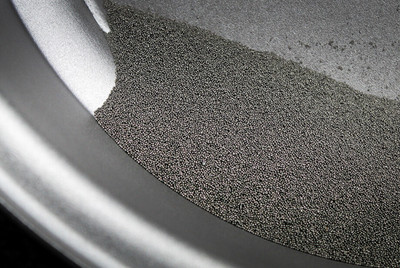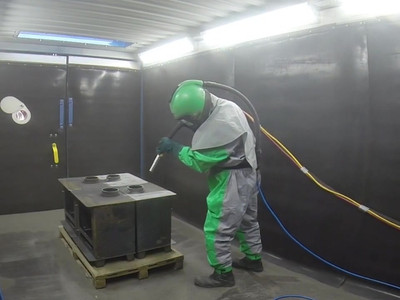27th Sep 2024
Abrasive blasting, often referred to as sandblasting, which is an outdated term, is a technique used to clean, polish, or prepare surfaces by propelling abrasive media at high velocities. This process is fundamental where surface preparation is crucial for subsequent treatments like painting, coating, or bonding. There are several types of abrasive blasting, each with unique properties and applications. In this blog, we’ll explore the most common methods used today.
What are the types of abrasive blasting used?
- Sand blasting – In the UK, regulations such as the Control of Substances Hazardous to Health (COSHH) Regulations and the Health and Safety at Work etc. Act 1974 aim to protect workers from exposure to hazardous substances, including silica dust. In the UK, it is recommended that silica sand (or any other substance containing more than 1 percent crystalline silica) be prohibited as an abrasive blasting material because workers are at risk of developing silicosis and risk is difficult to control. Instead, media such as glassia grit can be used, as it is a multi-purpose expendable abrasive, safe alternative to silica sand.
- Wet blasting – Also known as vapour blasting. This combines water with an abrasive material to reduce dust and improve safety during the blasting process. This method is preferred in environments where dust control is a priority. Wet blasting minimises airborne particles, making it safer for workers and more environmentally friendly, while still effectively cleaning and prepping surfaces for further treatment.
- Vacuum blasting – Also known as dustless blasting. A type of surface cleaning that uses a machine to propel abrasives at high pressure, the suction on the machine will then remove any propelled materials and surface contaminants. It’s an extremely effective and portable solution for treating localised areas of substrate.
- Centrifugal blasting – Also known as wheel blasting. It uses a blade wheel which propels abrasives at high velocity towards the surface being cleaned. An advantage of using centrifugal blasting is that it doesn’t use compressed air, and can be automated and installed into a production line to process repeated shapes and materials.
- Shot blasting – A surface treatment where tiny spheres of material are shot at high speed to remove oxidisation and other dirt or debris against the surface of a workpiece. It does this through what is known as peening, using the mechanism of plasticity/plastic deformation, spreading the substrate and dimpling it. It is ideal for applications in construction and heavy industry. It is particularly valued for its ability to not only clean but also enhance the durability of metal surfaces by improving their resistance to fatigue and corrosion.
- Direct abrasion/bristle blasting – A rotary tool with wire bristles is used to abrade surfaces without using loose media. This technique is especially effective for removing rust, corrosion, and old coatings from small, targeted areas. Bristle blasting is often used in maintenance and repair work on steel structures, such as pipelines, tanks, or metal beams, providing a more controlled and cleaner process than traditional abrasive blasting methods.
- Bead blasting – This uses fine glass or plastic beads as the abrasive medium, which provides a gentler cleaning process compared to sand or shot blasting. It is typically used for polishing and cleaning delicate materials or parts, such as in the automotive and aerospace industries, where precision and surface protection are crucial. Bead blasting is ideal for cleaning without causing damage to sensitive surfaces, making it a go-to option for applications requiring a fine, smooth finish.
- Steel grit blasting – An aggressive method that uses angular steel grit to clean and prepare metal surfaces. It’s frequently applied in industrial settings like shipyards and steel factories, where tough rust, scale, and old coatings need to be removed before surface treatments like painting. Steel grit blasting is favoured for its ability to provide deep cleaning while leaving a rough texture that helps coatings adhere better.
You can see our full range of media abrasive available on our website here, or for more guidance you can download our Abrasives & Media Guide here.
What factors determine the choice of a blasting method?
When selecting an abrasive blasting method, several key factors come into play. The type of surface material is crucial; delicate materials require gentler methods like bead blasting, while harder surfaces can withstand more aggressive techniques like stainless steel grit blasting. The condition of the surface, whether heavily rusted or lightly contaminated, also dictates the choice of method. Desired surface finish, environmental considerations like dust control, project scale, and cost all influence the decision. Additionally, health and safety concerns, such as silica dust hazards or toxic coatings, as well as cleanup requirements, play significant roles in determining the most suitable blasting method for a specific task.
Common safety hazards
Common safety hazards in abrasive blasting include:
- Respiratory hazards: Inhalation of dust, especially silica dust from sandblasting, can lead to lung diseases like silicosis. Proper respiratory protection is essential.
- Flying debris: High-velocity abrasive particles can cause eye injuries or skin damage, making helmets and protective overall clothing crucial.
- Toxic substances: Some abrasives or coatings being removed may contain hazardous chemicals like lead or asbestos, requiring containment and proper ventilation.
- Noise: Abrasive blasting can be extremely loud, posing a risk of hearing loss. Ear protection like earplugs or ear defenders should be used.
- Slips, trips, and falls: Wet blasting methods can create slippery surfaces, while hoses and equipment can create tripping hazards.
- Equipment malfunction: High-pressure blasting equipment can cause injuries if improperly used or maintained, requiring regular inspections and training for operators. We offer total servicing, maintenance, and inspection for abrasive blasting equipment, whether on-site or sent to us. Click here for more information on our servicing availability.
- Exposure to high pressure: Direct contact with high-pressure streams can result in serious physical injury, including cuts or punctures.
Proper safety training, personal protective equipment (PPE), and ventilation are key to mitigating these risks and should be taken into consideration when choosing a blasting method. You can see our PPE range available on our website here.
Conclusion
Each type of abrasive blasting serves different purposes, and the right choice depends on the material being worked on, the desired finish, and the specific application. As industries evolve, so do blasting techniques, offering greater precision, safety, and environmental friendliness. By understanding the strengths and limitations of each method, you can select the best abrasive blasting technique for your project, ensuring optimal results every time.




